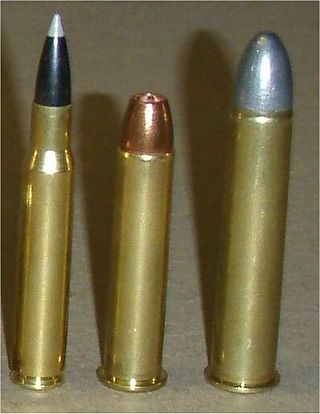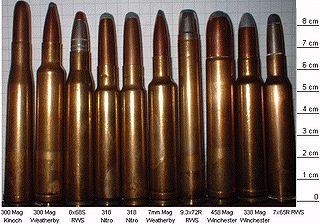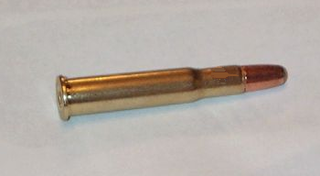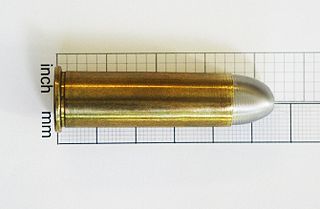
A rifle is a long-barreled firearm designed for accurate shooting and higher stopping power, with a barrel that has a helical or spiralling pattern of grooves (rifling) cut into the bore wall. In keeping with their focus on accuracy, rifles are typically designed to be held with both hands and braced firmly against the shooter's shoulder via a buttstock for stability during shooting. Rifles have been used in warfare, law enforcement, hunting and target shooting sports.

In firearm designs, the term single-shot refers to guns that can hold only a single round of ammunition inside and thus must be reloaded manually after every shot. Compared to multi-shot repeating firearms ("repeaters"), single-shot designs have no moving parts other than the trigger, hammer/firing pin or frizzen, and therefore do not need a sizable receiver behind the barrel to accommodate a moving action, making them far less complex and more robust than revolvers or magazine/belt-fed firearms, but also with much slower rates of fire.

The .357 Smith & Wesson Magnum, .357 S&W Magnum, .357 Magnum, or 9×33mmR is a smokeless powder cartridge with a 0.357 in (9.07 mm) bullet diameter. It was created by Elmer Keith, Phillip B. Sharpe, and Douglas B. Wesson of firearm manufacturers Smith & Wesson and Winchester. The .357 Magnum cartridge is notable for its highly effective terminal ballistics.

An elephant gun is a large caliber gun, rifled or smoothbore, originally developed for use by big-game hunters for elephant and other large game. Elephant guns were black powder muzzle-loaders at first, then black powder express rifles, then later used smokeless powder cartridges.

The .22 Long Rifle, also known as the .22LR or 5.6×15mmR, is a long-established variety of .22 caliber rimfire ammunition originating from the United States. It is used in a wide range of firearms including rifles, pistols, revolvers, and submachine guns.
Internal ballistics, a subfield of ballistics, is the study of the propulsion of a projectile.

The .45 Colt (11.43×33mmR), often called the .45 Long Colt, is a rimmed, straight-walled, handgun cartridge dating to 1872. It was originally a black-powder revolver round developed for the Colt Single Action Army revolver. This cartridge was adopted by the U.S. Army in 1873 and served as an official US military handgun cartridge for 19 years, before being replaced by the .38 Long Colt in 1892. Although there has never been a ".45 Short Colt" cartridge, the .45 Colt is frequently called the ".45 Long Colt" to better distinguish it from the shorter .45 Schofield cartridge, which was also in use around the time the .45 Colt was introduced.
The .30-06 Springfield cartridge, 7.62×63mm in metric notation, and called the .30 Gov't '06 by Winchester, was introduced to the United States Army in 1906 and later standardized; it remained in military use until the late 1970s. In the cartridge's name, ".30" refers to the nominal caliber of the bullet in inches; "06" refers to the year the cartridge was adopted, 1906. It replaced the .30-03 Springfield, 6mm Lee Navy, and .30-40 Krag cartridges. The .30-06 remained the U.S. Army's primary rifle and machine gun cartridge for nearly 50 years before being replaced by the 7.62×51mm NATO and 5.56×45mm NATO, both of which remain in current U.S. and NATO service. The cartridge remains a very popular sporting round, with ammunition produced by all major manufacturers.

The 7×57mm Mauser is a first-generation smokeless powder rimless bottlenecked rifle cartridge. It was developed by Paul Mauser of the Mauser company in 1892 and adopted as a military cartridge by Spain in 1893. It was subsequently adopted by several other countries as the standard military cartridge, and although now obsolete as a military cartridge, it remains in widespread international use as a sporting round. The 7×57 Mauser was a popular stalking cartridge and sporting rifles in this chambering were made by the famous British riflemakers, such as John Rigby, Holland and Holland, Westley Richards and others. British cartridge nomenclature designated caliber in inches, and the cartridge was known as the .275 bore after the measurement of a 7 mm rifle's bore across the lands. The cartridge is sometimes erroneously referred to as the ".275 Rigby", However, the original John Rigby & Sons never referred to the cartridge by that name, nor did any of UK gun trade; the Rigby association is a misconception attributed to modern American gun writers.

The .45-70, also known as the .45-70 Government, .45-70 Springfield, and .45-21⁄10" Sharps, is a .45 caliber rifle cartridge originally holding 70 grains of black powder that was developed at the U.S. Army's Springfield Armory for use in the Springfield Model 1873. It was a replacement for the stop-gap .50-70 Government cartridge, which had been adopted in 1866, one year after the end of the American Civil War, and is known by collectors as the "Trapdoor Springfield".

The .458 Winchester Magnum is a belted, straight-taper cased, Big Five game rifle cartridge. It was introduced commercially in 1956 by Winchester and first chambered in the Winchester Model 70 African rifle. It was designed to compete against the .450 Nitro Express and the .470 Nitro Express cartridges used in big bore British double rifles. The .458 Winchester Magnum remains one of the most popular large game cartridges, and most major ammunition manufacturers offer a selection of .458 ammunition.

The .30-30 Winchester / 7.8x51mmR cartridge was first marketed for the Winchester Model 1894 lever-action rifle in 1895. The .30-30, as it is most commonly known, along with the .25-35 Winchester, was offered that year as the United States' first small-bore sporting rifle cartridges designed for smokeless powder. Since its introduction, it has been utilized alongside the development of flatter shooting cartridges, most prominently those derived from designs subsidized by interest in military expenditures. The .30-30 has remained in widespread use almost entirely because of reliable effectiveness in civilian applications, and has put food on the table for millions of people in hunting situations.

Overpressure ammunition, commonly designated as +P or +P+, is small arms ammunition that has been loaded to produce a higher internal pressure when fired than is standard for ammunition of its caliber, but less than the pressures generated by a proof round. This is done typically to produce ammunition with higher muzzle velocity, muzzle energy, and stopping power, such as ammunition used for security, defensive, or hunting purposes. Because of this, +P ammunition is typically found in handgun calibers which might be used for paramilitary forces, armed security, and defensive purposes.

The 7mm Remington Magnum rifle cartridge was introduced as a commercially available round in 1962, along with the new Remington Model 700 bolt-action rifle. It is a member of the belted magnum family that is directly derived from the venerable .375 H&H Magnum. The original purpose of the belted magnum concept taken from the .300 H&H Magnum and .375 H&H Magnum, was to provide precise headspace control, since the sloping shoulders, while easing cartridge extraction, were unsuitable for this purpose. Improved cartridge extraction reliability is desirable while hunting dangerous game, in particular when a fast follow-up shot is required. The 7mm Remington Magnum is based on the commercial .264 Winchester Magnum, .338 Winchester Magnum, and .458 Winchester Magnum, which were based on the same belted .300 H&H Magnum and .375 H&H Magnum cases, trimmed to nearly the same length as the .270 Weatherby Magnum.

The 8mm Remington Magnum belted rifle cartridge was introduced by Remington Arms Company in 1978 as a new chambering for the model 700 BDL rifle. The 8mm Remington Magnum's parent case is the .375 H&H Magnum. It is a very long and powerful cartridge that cannot be used in standard length actions, such as those that accommodate the .30-06 Springfield.

The .50-70 Government / 12.7 x 45 mm R, also known as the .50-70 Musket, .50-70 Springfield, and .50-1+3⁄4" Sharps) is a black powder cartridge adopted in 1866 for the Springfield Model 1866 trapdoor rifle.
The .45-90 Sharps, also known as the .45-24⁄10" Sharps, is a black powder rifle cartridge introduced in 1877 by the Sharps Rifle Manufacturing Company and was developed for hunting and long range target shooting. In the modern day, it is used for Black Powder Cartridge Rifle competitions.

The .50-140 Sharps, also known as the .50-31⁄4" Sharps, is a black-powder rifle cartridge that was introduced in 1884, as a big game hunting round. It is believed to have been introduced for the Sharps-Borchardt Model 1878 rifle. The cartridge is very similar to the .500 Black Powder Express.
The 6 bore, also known as the 6 gauge, is an obsolete caliber that was used commonly in 19th-century black-powder firearms.

The .500 Nitro Express is a rifle cartridge designed for hunting large and dangerous game animals in Africa and India. This cartridge was primarily designed for use in double rifles though various single shots were produced on the Farquarson action and at least one major company (Heym) produced it in bolt-action configuration. It was commonly available in two lengths: a 3.00 in (76 mm) and a 3.25 in (83 mm) version.

















